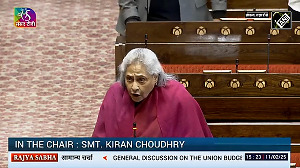'As the global economy undergoes significant transformations in 2025, India's ability to navigate the complexities of trade wars, financial realignments, and emerging blocs will be pivotal,' explain Harsh V Pant and Soumya Bhowmik.

As nations navigate significant disruptions and realignments, 2025 is a crucial year for global economics.
The re-election of Donald Trump has brought a resurgence of global trade protectionism, creating substantial volatility in international markets.
During his first term, Mr Trump focused on 'America First' policies, implementing tariffs, trade restrictions, and stricter visa regulations that had a notable impact on sectors such as information technology services, textiles, and pharmaceuticals -- key drivers of India's GDP and employment.
In fact, the prospect of tighter H-1B visa rules poses a serious challenge to the IT industry, which relies on US markets for nearly 60 per cent of its revenue.
In addition, Mr Trump's aggressive trade stance against China has heightened global supply chain disruptions, creating both challenges and opportunities for India to position itself as an alternative manufacturing hub.
However, these shifts increase uncertainty in trade flows, impacting investor confidence.
Coupled with concerns over a stronger US dollar leading to capital outflows, Indian markets have also reflected apprehensions about the potential economic and geopolitical repercussions of another Trump administration.
Competing and thriving:
Historically, the US-China trade wars have had ripple effects on global markets.
Indian exporters face indirect consequences of US-China tensions, such as heightened competition in third markets where Chinese goods are diverted due to US tariffs.
For example, in Southeast Asia, India's textile industry has had to compete with Chinese exports redirected from the US market, intensifying price pressures and forcing Indian producers to adapt quickly to retain market share.
Despite these challenges, the disruption in global trade flows also creates unique opportunities for India to position itself as an alternative manufacturing destination.
As multinational corporations seek to diversify their supply chains to reduce dependence on China, India has emerged as a key beneficiary.
The government's production-linked incentive schemes have played a critical role in attracting global manufacturers. The PLI schemes aim to provide financial incentives for manufacturers in sectors such as electronics, pharmaceuticals, and automobiles.
For example, the scheme has allocated about $25 billion across 13 key sectors, aiming to boost domestic production and exports.
This aligns with the broader Atmanirbhar Bharat (self-reliant India) initiative.
Under these schemes, companies like Apple, Foxconn, and Samsung have expanded their operations in India, signalling growing investor confidence in the country's manufacturing potential.
Another significant opportunity lies in India's ability to leverage its skilled labour force and startup ecosystem to attract investments in high-value industries.
For instance, India's IT services sector is steadily climbing up the value chain, with a growing focus on emerging technologies such as artificial intelligence and blockchain.
This positions India as a critical player in the global knowledge economy, even as traditional sectors face headwinds from protectionist policies.
However, these gains are not without risks. The broader global economic context remains challenging, with the United Nations projecting a subdued global growth rate of 2.8 per cent for 2025.
Sluggish growth in advanced economies and the strengthening of the US dollar could reduce foreign direct investment inflows into emerging markets such as India.
A stronger dollar also increases the cost of imports, mainly energy and raw materials, putting additional pressure on India's trade deficit.
Diversification in a fragmenting global order:
India faces the potential challenge of a Trump-Xi rapprochement that could significantly reshape the global trade landscape.
Speculation about a possible agreement involving increased Chinese imports of US agricultural and energy products raises concerns for India, as such a deal could divert trade flows away from emerging economies.
A closer US-China economic partnership could reinforce China's dominance in global supply chains, undermining India's efforts to position itself as a viable alternative manufacturing hub.
This would weaken the momentum behind the China Plus One strategy, which has been driving multinational corporations to diversify their manufacturing bases beyond China in the post-pandemic world.
To mitigate the risks associated with shifting global trade dynamics, India is actively pursuing a strategy of market diversification and bilateral engagement.
Strengthening trade agreements with Southeast Asia, Africa, and Europe has become a central pillar of this approach.
Initiatives such as the India-EU Trade and Technology Council are designed to bolster collaboration in critical areas, including digital trade.
India's participation in the Indo-Pacific Economic Framework underscores its commitment to fostering economic partnerships that reduce dependency on any single trade bloc.
By engaging with key economies in the Indo-Pacific, India aims to secure its strategic interests while enhancing its role in global trade.
India is also recalibrating its role within broader economic groupings such as Brics, as the bloc expands through the 'Brics Plus' initiative.
By incorporating key energy producers such as the UAE and resource-rich nations like Iran, Brics has strengthened its influence in global markets for critical resources, including lithium and oil.
While China and Russia often frame Brics as a counterbalance to Western dominance, India adopts a pragmatic approach, leveraging the bloc for equitable global governance while maintaining ties with Western economies.
As the global economy undergoes significant transformations in 2025, India's ability to navigate the complexities of trade wars, financial realignments, and emerging blocs will be pivotal.
Strengthening bilateral trade agreements, diversifying export markets, and championing institutional reforms are essential components of a forward-looking strategy.
India's geoeconomic success will depend on its ability to balance collaboration with autonomy in a rapidly changing global landscape.
Harsh V Pant and Soumya Bhowmik are respectively, vice-president and fellow, Observer Research Foundation, New Delhi.
Feature Presentation: Aslam Hunani/Rediff.com












 © 2025
© 2025